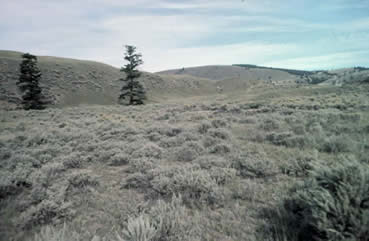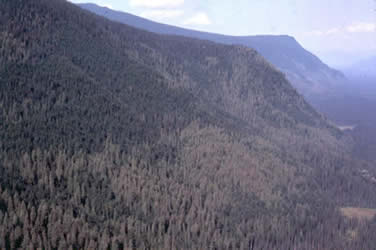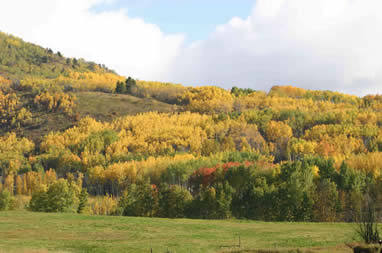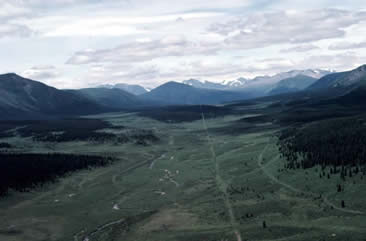

TERRESTRIAL VEGETATION OF BRITISH COLUMBIA

Scrub vegetation in British Columbia, photo by Del Meidinger
by
Del Meidinger
(Modified from The Ecosystems of British Columbia by
Meidinger and Pojar 1991)
The vegetation of British Columbia ranges from wet coastal forest to dry interior grassland, from sea level salt marsh to alpine tundra, and from Garry oak parkland to black spruce muskeg. Numerous systems of vegetation classification exist and could be applied to the province's plant cover. However, for the brief outline that follows, a primarily physiognomic scheme has been used.
Coniferous forest
Evergreen coniferous forest dominates the province's vegetative cover. The majority of the coastal forest at low to medium elevations is dominated by western hemlock (Tsuga heterophylla) and western redcedar (Thuja plicata), with Douglas-fir (Pseudotsuga menziesii) abundant in the south and amabilis fir (Abies amabilis) and Sitka spruce (Picea sitchensis) abundant in the north. Arbutus (Arbutus menziesii - a broad-leaved evergreen tree) typically joins Douglas-fir in much of the drier forest near the sea in the Strait of Georgia region. Mountain hemlock (Tsuga mertensiana), amabilis fir, and, to a lesser extent, yellow-cedar (Chamaecyparis nootkatensis) predominate in the coastal subalpine forest.
Ponderosa pine (Pinus ponderosa) and Douglas-fir dominate the dry forest, parkland, and savanna of the southern Interior. Western larch (Larix occidentalis), a deciduous conifer, is a common associate in southeastern British Columbia.
Lodgepole pine (Pinus contorta var. latifolia) and Douglas-fir form extensive stands over much of the southern half of the Interior Plateau. Douglas-fir gradually drops out from the northern half, where white spruce (Picea glauca), hybrid white spruce (P. engelmannii x glauca), and subalpine fir (Abies lasiocarpa) join lodgepole pine as the dominant conifers.
The wetter parts of the Columbia and Southern Rocky mountains region are occupied by forests of western hemlock and western redcedar, with admixtures of western white pine (Pinus monticola), Douglas-fir, western larch, grand fir (Abies grandis), Engelmann spruce (Picea engelmannii), hybrid white spruce, and subalpine fir.

Coniferous Forest in BC, photo by Del Meidinger
The upper elevation forest and parkland of the southern two-thirds of interior British Columbia consist primarily of mixtures of Engelmann spruce, subalpine fir, and lodgepole pine, with whitebark pine (Pinus albicaulis) fairly common on drier sites.
The low and middle elevation forest of northern British Columbia is boreal in character and dominated by white spruce, black spruce (Picea mariana), and lodgepole pine. Northern subalpine forest consists primarily of white spruce and subalpine fir.
Deciduous forest
Trembling aspen (Populus tremuloides) is the most widespread and abundant deciduous tree species in British Columbia. Aspen stands (which may occur as closed forest or in parkland) are abundant throughout the Interior Plateau and in the boreal forest region, but they are less frequent in the wetter parts of the southeastern province and at higher elevations, and are uncommon at the coast.
Red alder (Alnus rubra) is a fast-growing pioneer species that forms dense stands on much cut-over or otherwise disturbed land all along the Coast.
Black cottonwood (Populus balsamifera ssp. trichocarpa) commonly forms alluvial forests throughout the province, except on the outer coast. Balsam poplar (P. balsamifera ssp. balsamifera) largely replaces black cottonwood in northern British Columbia.
Paper birch (Betula papyrifera) is widespread in the Interior but seldom dominates extensive stands. It usually occurs in mixture with conifers and other deciduous trees.

Deciduous forest in BC, photo by Will MacKenzie,
Courtesy of the BC Ministry of Forests
Bigleaf maple (Acer macrophyllum) is common in second-growth forest in southwestern British Columbia, but it also rarely dominates stands.
Garry oak (Quercus garryana) is virtually restricted to southeastern Vancouver Island and adjacent Gulf Islands, where it forms a distinctive type of deciduous forest and parkland or savanna.
Scrub
Shrubby vegetation dominates the landscape in parts of three lowland areas of British Columbia:

Scrub vegetation in BC, photo by Del Meidinger
Scrub is also dominant at high elevations throughout the province. Willows form subalpine and alpine scrub over much of the Interior; Betula nana often occurs with the willows, especially in the North. Species of Vaccinium form high elevation scrub, especially on coastal and snowier interior mountains. Slide tracks and some north coastal alpine communities are dominated by Alnus viridis ssp. sinuata (Sitka alder). Dwarf scrub is another widespread, abundant form of high elevation vegetation. Dwarf shrubs, evergreen-leaved (such as Cassiope and Phyllodoce spp. [mountain-heathers], Empetrum nigrum, Dryas spp. [mountain-avens]) or deciduous (Salix spp., Vaccinium spp.), dominate many subalpine and alpine heath and tundra communities.
Elsewhere in the province scrub can be extensive or (more often) localized, and usually develops after fire or as wetland vegetation.
Grass
In this treatment, grass vegetation consists primarily of grasses and other grass-like plants. Hence, as a form of vegetation it includes marshes and grassy tundra as well as typical grassland vegetation.
Grasslands dominated by bunchgrasses, other grasses, and also shrubs occur in valley bottoms and on several plateaus in southcentral British Columbia, from the Riske Creek area in the Chilcotin district south to the international border. Similar grasslands occupy smaller areas in southeastern British Columbia. Pseudoroegneria spicata (bluebunch wheatgrass; formerly known as Agropyron spicatum) is the most widespread and dominant species. Other abundant or frequent species include Festuca altaica s. lat. (Altai fescue; including F. scabrella, rough fescue), F. idahoensis (Idaho fescue), Poa sandbergii s.lat.(syn. Poa secunda) (Sandberg's bluegrass), Koeleria macrantha (junegrass), Bromus tectorum (cheatgrass), Hesperostipa comata (needle-and-thread grass), Achnatherum (=Stipa) richardsonii (spreading needlegrass), Hesperostipa curtiseta (porcupinegrass; formerly known as Stipa spartea var. curtiseta), Poa pratensis (Kentucky bluegrass), Artemisia tridentata, A. frigida (pasture sage), and Ericameria (=Chrysothamnus) nauseosus.
The drier, rainshadow areas of southwestern British Columbia have small pockets of grassland, usually on warm, rocky, south-facing slopes, and are associated with dry woodland of Douglas-fir, arbutus, and Garry oak. These vernal grasslands are dominated by annual species of Bromus (bromegrass), Vulpia (fescue), and Aira (hairgrass). They include many introduced species as well as showy, spring-flowering forbs, and are closely related to the annual grasslands of Oregon and California.
In the northern two-thirds of the province, lower elevation grasslands are usually localized and restricted to steep, south-facing slopes. Some typical species are Elymus trachycaulus (slender wheatgrass), Festuca altaica, Calamagrostis purpurascens (purple reedgrass), Achnatherum richardsonii, Achnatherum nelsonii (stiff needlegrass; formerly known as Stipa columbiana), Leymus innovatus (fuzzy-spiked wildrye), Poa glauca (glaucous bluegrass), Artemisia frigida, and A. campestris (northern wormwood).

Grasslands in BC, photo by Alison Nicholson,
courtesy of the BC Ministry of Forests
High elevation grass vegetation occurs throughout the province in the drier alpine areas. Dominant grasses vary from south to north, but include Festuca altaica (now including former F. scabrella), F. viridula (green fescue), F. brachyphylla (alpine fescue), Poa arctica (arctic bluegrass), Hierochloe alpina (alpine sweetgrass), and Calamagrostis purpurascens. Species of the sedge family often dominate or co-dominate the vegetation. Some typical species are Carex phaeocephala (dunhead sedge), C. spectabilis (showy sedge), C. microchaeta (small-awned sedge), C. nardina (spikenard sedge), C. albonigra (two-toned sedge), C. scirpoidea ssp. pseudoscirpoidea (single-spiked sedge), C. capitata (capitate sedge), and Kobresia myosuroides (Bellard's kobresia).
Wetland grass types include several different kinds of marsh and fen vegetation. Freshwater marshes and fens are usually dominated by sedges or grasses. Some typical species include Carex aquatilis (water sedge), C. utriculata (beaked sedge), C. vesicaria (inflated sedge), C. nigricans (black alpine sedge), Schoenoplectus acutus & S. tabernaemontani (great bulrush; formerly Scirpus lacustris s. lat.), Trichophorum caespitosum (tufted clubrush), Phalaris arundinacea (reed canarygrass), and Phragmites australis (common reed), among many others. Coastal saline marshes are frequent but usually not extensive; their most characteristic dominant species are Carex lyngbyei (Lyngbye's sedge) and Deschampsia cespitosa (tufted hairgrass). Alkaline marshes occur in the dry southern Interior and have species such as Distichlis spicata var. stricta (alkali saltgrass), Muhlenbergia asperifolia (alkali muhly), Hordeum jubatum (foxtail barley), Juncus balticus (Baltic rush), Schoenoplectus spp. (bulrush), Salicornia europaea (European glasswort), and Suaeda depressa (seablite).
Broad-leaved herb
Timberline meadows are the only widespread, natural, broad-leaved herbaceous vegetation type in British Columbia. Such meadows are most abundant at high elevations of the southern two-thirds of the Interior of the province. Typically they include Senecio triangularis (arrow-leaved groundsel), Veratrum viride (false hellebore), Valeriana sitchensis (Sitka valerian), Erigeron peregrinus (subalpine daisy), and Lupinus arcticus (arctic lupine). Somewhat similar (but usually with more Heracleum maximum [cow-parsnip] and Epilobium angustifolium [fireweed]) meadows occur at middle elevations here and there, often associated with aspen forests, but typically such moist montane meadows are small, localized, and almost invariably disturbed—usually by grazing.
Seasonal herb meadows also occur locally in the Strait of Georgia region and in some openings in the dry forest of the southern Interior.
Bryoid
Vegetation dominated by mosses, liverworts, or lichens usually occurs in environments too harsh for vascular plants. British Columbia, for example, has raised Sphagnum bogs, rock outcrops partially covered by lichens and mosses such as Racomitrium, Polytrichum, and Dicranum, and alpine lichen tundra.

Bryoid vegetation in BC, photo by Del Meidinger
Meidinger, Del and Jim Pojar. 1991. Ecosystems of British Columbia. BC Ministry of Forests. (PDF files available on-line)
R.T. Ogilvie. 1998. Vascular Plants. In: Smith, I.M., and G.G.E. Scudder, eds. Assessment of species diversity in the Montane Cordillera Ecozone. Burlington: Ecological Monitoring and Assessment Network, 1998. (Includes discussion of floristics patterns.)

Wetland Vegetation in BC, photo by Del Meidinger
Please cite these pages as:
Author, Date. Page title. In Klinkenberg, Brian. (Editor) 2017. Biodiversity of British Columbia [www.biodiversity.bc.ca]. Lab for Advanced Spatial Analysis, Department of Geography, University of British Columbia, Vancouver.
All material found on this web site is covered by Canadian Copyright Laws. Please contact the respective copyright holder if you wish to use any illustration, photograph or text.